What is indicated by the LEDs?
Could the vacuum damage my camera or lenses?
Will the vacuum affect the depth to which I can take my housing?
My housing is rather tight on space. How much room do the components of the Housing Sentry need?
What is included with the Housing Sentry?
What are my pump choices and what is recommended?
Can I install the Housing Sentry myself?
What is involved in the installation of the Housing Sentry?
What fittings are used with the Housing Sentry and why are they special?
What is the purpose of the
block-off plug?
What battery does the Housing Sentry use? What is the cost and how difficult is it to replace?
How often will the battery need to be replaced?
Does the Housing Sentry eliminate the possibility of a flooded housing?
What happens to my Housing Sentry if, in the future, I decide to get a new housing?
Does the Housing Sentry come with a warranty?
What is the difference between the Housing Sentry and the Housing Sentry Basic?
The Housing Sentry is designed for you to pull a vacuum on your housing of at least ten inHg. The electronics will continuously monitor the status and trigger the flashing of the green LED to indicate the maximum vacuum level has been reached and is being maintained. The red LED will slowly flash if the vacuum drops below nine inHg and will flash rapidly if the vacuum drops below six inHg. The red LED will blink at a fast rate if there is water present at the moisture pick-up strips. A vacuum at the recommended level of ten inHg is equivalent to being at an altitude of 9,300 feet. For referance, airplanes are normally pressurized to the equivalent altitude of 8,000 feet. There has been no evidence found to indicate that a vacuum of this level causes any equipment damage based on research of the similar units that have been available on the market for the past several years. A vacuum of ten inHg creates a pressure differential equivalent to 11.3 feet of depth. You should deduct 11.3 feet
from the maximum depth recommended for your particular housing. The electronic circuit board assembly is a compact 2.01” x 1.01” x 0.290” thick or 51.06mm x 25.65mm x 7.37mm thick. U.S Measurements in inches Metric Measurements in millimeters The complete Housing Sentry includes the electronic circuit board assembly with the wires, LEDs and moisture pick-up strips connected, battery, vacuum connector, input fitting, block-off
plug, special high-bond mounting tape plus your choice of a vacuum pump. You may choose from two different vacuum pumps. Our recommended pump is a lightweight, manual pump however we recognize that some may prefer a rechargeable pump. Here are pictures of the vacuum pumps we offer.
Manual Pump Advantages Rechargeable Pump Advantages
• Manual so no electric or battery power is needed
•
•
Lightweight – pump, gauge, hose and fitting weigh only 11 ounces
•
Lightweight – pump, hose, fitting and charger weigh 11.7 ounces • Includes vacuum gauge • Replacement parts are available Rechargeable Pump Disadvantages • Manual Pump Disadvantages • • No replacement parts are available
Can I install the Housing Sentry myself? The Housing Sentry can be self-installed by anyone with a good level of do-it-yourself skills and the proper tools. Written installation instructions are provided and, if needed, e-mail and phone support are available. If preferred, the Housing Sentry can by installed by UnderWater Camera Stuff at a fee of $175. The type of housing you have and its configuration will dictate what is involved in the installation of the Housing Sentry.
Customized fittings have been developed for three different installation options. UnderWater Camera Stuff is willing to develop other customized vacuum connectors as new installation options present themselves. The current options for the installation of the Housing Sentry are: Electronics Installation The first step is to determine the best location for the electronic board assembly, the LEDs and the moisture pick-up strips. The
preferred location for the board assembly is an area as high in the housing as possible and where the battery holder can be easily accessed for replacement of the battery. All components must be on the same half of the housing. It is also important to choose a place that is within seven inches (177.8mm) of the position(s) you choose for the LEDs since that is the length of the attached LED wires. The electronics board and moisture pick-up strips are secured with special, high-bond, double-stick tape. Some soldering may be
required if you want to shorten the LED or moisture sensor wires.
What fittings are used with the Housing Sentry
and why are they special?
All of the fitting are made of 316 stainless steel. Although these may appear to be off-the-shelf items, all the fittings must be customized to work properly with our system. The seal of each fitting is rated at 4000 PSIG @ 70 °F / 275 BAR @ 21 °C which is equivalent to being at a depth of 9000 feet.
Nikonos Bulkhead Vacuum Connector, this fitting does not require an extra hole in housing
and installs in a Nikonos flash port.
1/2" Bulkhead Hole Vacuum Connector, this fits into existing bulkhead hole in Aquatica and Sea&Sea Housings.
14mm Bulkhead Vacuum Connector, this fits into existing bulkhead hole in Nauticam
/ Seacam / Subal Housings.
Block-Off Plug, used in the Vacuum Connector when in the water
ikelite
Control Location Vacuum Connector, is used to replace an unused control
knob in an ikelite housing
The plug keeps salt and other debris out of the vacuum connector. The
vacuum connector can leak if exposed to enough pressure. With the plug
installed, the vacuum connector can handle pressure of 4,000 PSIG @ 70 °F /
275 BAR @ 21 °C which is equivalent to being at a depth of 9000 feet.
Our testing shows that the vacuum connector without the plug will leak when
exposed to a pressure of 80 psi which is equivalent to 150’ of depth.
What battery does the Housing Sentry
use? What is the cost and how difficult is it to replace?
The battery is a coin cell, CR-2032, which is readily available and retails for less than $5. To replace the battery,
you only need to extract the old one from the spring-loaded battery holder
and slide in the new one, being careful not to get any body oils on the battery.
How often will the battery need to be replaced?
During our testing, the battery lasted for 240 hours of virtually constant activation. The Housing Sentry was active overnight in this test so it was
active about 23 hours per day and the battery lasted ten days. We only relieved the vacuum for short periods while camera batteries, memory chips and lenses
were exchanged. Once the change-out process was complete, a new vacuum was drawn and the Housing Sentry battery was back to work. The 240 hours
could translate into weeks of dive time depending on how long you leave the unit in a vacuum state. When no vacuum is drawn on the housing, the battery goes
into power-saver mode and no LEDs will be lighted.
On a normal dive trip where you would only have the housing under vacuum for about eight hours per day, we estimate that the battery would last at least 25 days
although your mileage may vary.
We designed the unit so that when the battery power is close to being exhausted, the green LED will no longer turn on but the red LED will continue to work.
If you see this, it is time to replace the battery.
Does the Housing Sentry eliminate the possibility of a flooded housing?
The Housing Sentry will significantly minimize the likelihood of a flooded housing but no one, including UnderWater Camera Stuff, can guarantee that a
flood will not happen to your equipment. When used properly, the Housing Sentry will aid you in detecting problems with your housing prior to entering
the water and continually monitor the status throughout your dive. It is your responsibility to correctly use the Housing Sentry.
What happens to my Housing Sentry if, in the future, I decide to get a new housing?
You will have up to three options from which to choose when you upgrade to a new system and housing. Does the Housing Sentry come with a warranty?
Yes, the Housing Sentry components are warranted from defects for a period of one year from date of purchase. The pump is warranted for a period
of 90 days.
What is the difference between the Housing Sentry and the Housing Sentry Basic? The Housing Sentry Basic is the low cost version of the Housing Sentry Complete. The Housing Sentry has electronic circuitry that
continually monitors the status of the vacuum as well as a built in moisture detector. These electronics can be added to the Housing Sentry
Basic at a later date to upgrade the Housing Sentry Basic to a Housing Sentry Complete.
How the Housing Sentry-Basic Works
How the Housing Sentry-Complete Works Housing Sentry Frequently Asked Questions Pictures of current Housing Sentry installs Send an e-mail to
The red LED will blink at a fast rate if the vacuum in the housing is between two inHg and six inHg.
The red LED will blink slowly if the vacuum in the housing is between six inHg and ten inHg.
The green LED will start blinking very slowly once the vacuum reaches ten inHg and will continue to periodically blink until the vacuum drops to less than nine inHg or the moisture sensor is activated.
Mouse over the pictures for a larger image

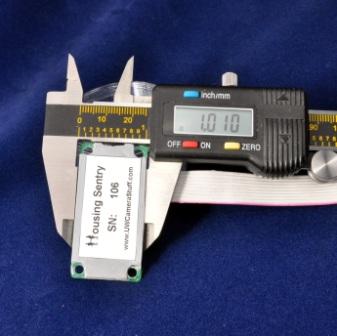
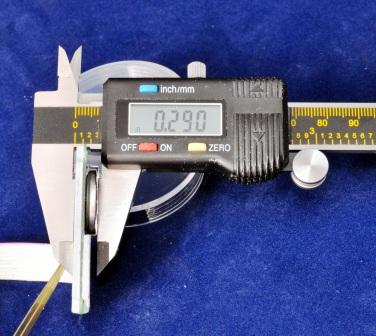
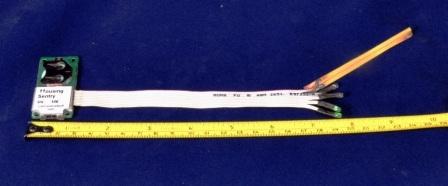
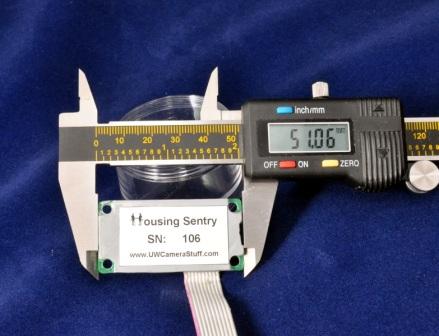

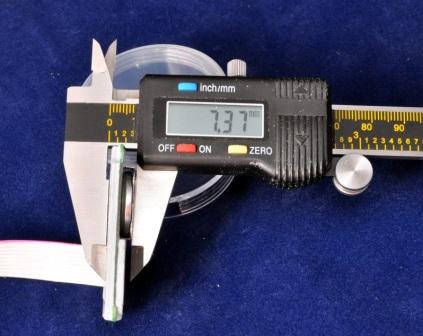
Mouse over the pictures
for a larger image
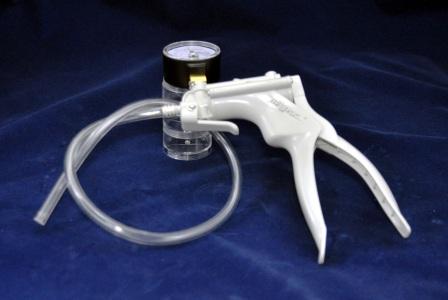
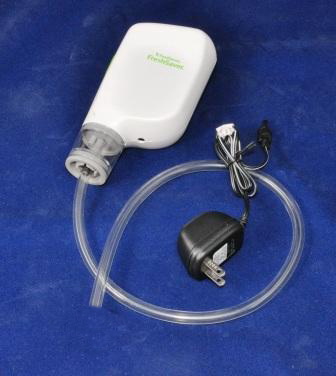
Manual pump
Rechargeable pump
The following table lists the advantages and disadvantages we have identified for each pump.
Can vacuum housing about 40 times on a full charge
•
Easy-to-use vacuum release lever
•
Easy, push-button operation
Electric power is needed to recharge
Does not include a vacuum gauge
•
Have to squeeze the handle about 80 times to pull the proper vacuum
•
Must remove hose from pump to release housing vacuum
•
Charger is 120V 60hz US only plug
Following are brief descriptions of the three installation options.
Since some manufacturers seal the bulkheads and the owner may not know if the bulkhead is or is not sealed, please contact the manufacturer. A vacuum cannot be drawn on the housing if the bulkhead is sealed. You will need to unseal the bulkhead if you choose this installation option.
Mouse over the pictures for a larger image
Acrylic Housing Vacuum Connector, this fitting requires a stepped and threaded hole in housing.
For use in an Ikelite Housing
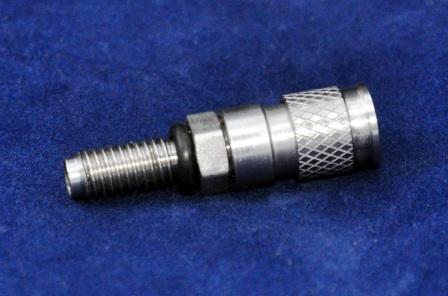
Vacuum Connector Measurement, protruding length is 1.08" or 27.45mm with a diameter
of 0.521" or 13.24mm
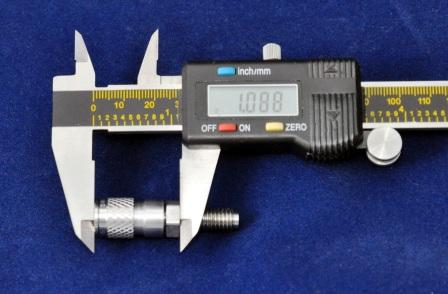
Aluminum Housing Vacuum Connector, this fitting requires a 11/32" hole in housing.
Can be used in any thin-walled housing.
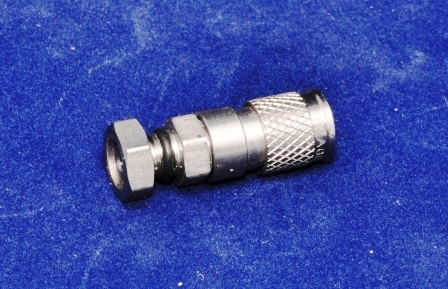
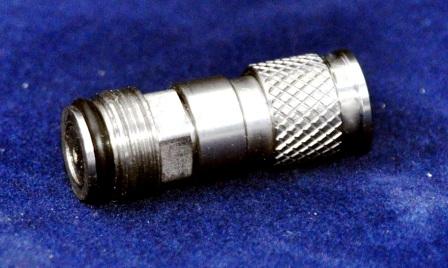

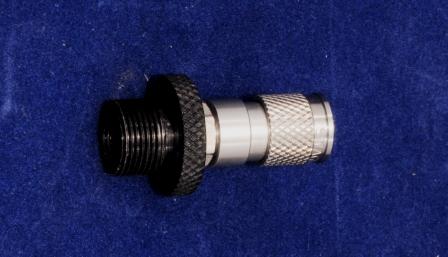
Barbed Hose Input Fitting, connects either manual or rechargeable pump to
Vacuum Conector
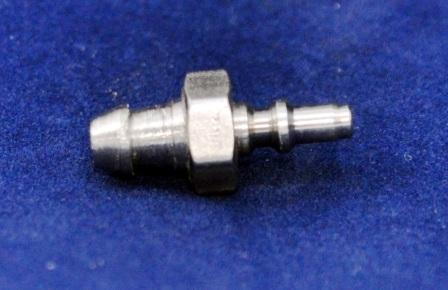
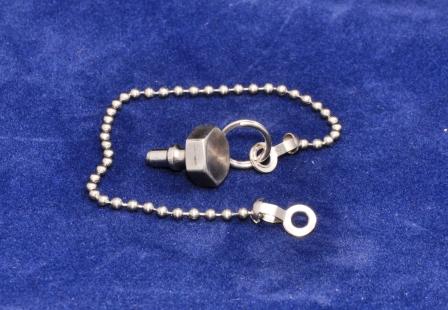

What is the purpose of the block-off plug?
LINKS
Last revised04/25/2015 12:05:49 PM